#Salonnière
Explore tagged Tumblr posts
Text
Frases Célebres
Frases Célebres Anne "Ninón" de l'Enclos (1620-1705) #aperturaintelectual #frasescelebresaintelectual
“Cuando nuestros sueños se han cumplido es cuando comprendemos la riqueza de nuestra imaginación y la pobreza de la realidad.” Anne “Ninón” de l’Enclos (1620-1705) Aristócrata, cortesana, mecenas y salonnière francesa. Sigue Apertura Intelectual en todas nuestras redes: WordPress Facebook Twitter Instagram LinkedIn Tumblr Reddit Mastodon Te invitamos a que califiques esta…

View On WordPress
#AperturaIntelectual#frasescelebresaintelectual#Anne "Ninón" de l&039;Enclos#Aristócrata. cortesana. mecenas y salonnière francesa#Frases Célebres#Imaginación#Realidad#Sueños
2 notes
·
View notes
Text

Florine Stettheimer (1871-1944), Tulips Under a Canopy, circa 1925. Oil on canvas. 40 x 32 in (101.6 x 81.3 cm). Estimate: $200,000-300,000. Offered in Modern American Art on 18 April at Christie’s in New York Florine Stettheimer (August 19, 1871 – May 11, 1944) was an American modernist painter, feminist, theatrical designer, poet, and salonnière. via Wikipedia
210 notes
·
View notes
Note
What's one thing you hate about your favourite figure of the Napoleonic era?
Only one thing I hate about Eugène... that's hard, actually.
I hate that he cheated on his wife, obviously, and how naturally and casually he did it. But there's worse. In fact, I once came across an anecdote by an Austrian female writer/salonnière who claimed that Eugène, during his stay in Vienna in 1809, tried to persuade her sister to grant him some sexual favours in exchange for the release of her husband who had been taken captive and faced severe consequences. (I wanted to look for the correct quote again but my brain is mush today, and I only remember it dimly. It did shock me a lot at the time. At least so far it's been the only mention of that kind that I have seen.)
I hate that he so rarely dared to stand up for himself, though I at the same time find it endearing, and surely something that I can understand and connect with. I've seen a mention about the Italian navy, how Napoleon's orders concerning it often were contradictory or otherwise didn't make much sense, but how Eugène - despite probably knowing better - was so overwhelmed by Napoleon's personality that he trusted Napoleon's judgement more than his own. That's probably true for many other situations, too.
But the one thing I hate the most is that he, up to 1812, was a soldier with all his heart. He wanted war, he hoped for war, so he could make up for the "glory" he had missed out during the years 1805 to 1807. I hate that it took the disaster of the Russian campaign for him to understand what war truly means.
Thanks for the Ask! 💖
14 notes
·
View notes
Text

After the Horticultural Show
---
"Thhunlight?" demanded my Amber Salonnière the moment I was conscious enough to form sentences. "Thherriouthhly?"
My senses had only returned begrudgingly, one by one, and I'd had a sense of time passing but not how much. They rarely attempted to speak, which hinted at what my condition must have been; the mound of heavy bandages over my head and right eye was another clue. I had been bandaged quite enthusiastically all over really, which was sweet.
I shrugged, immediately regretted it, and said hoarsely, "Dove off before I hit it." I glanced to the window. "Judging by the dreary view, everything appears to have worked out."
They made a rude squelching noise by way of reply. I smiled. There was zzoup and tea on the table, both steaming. Nothing else was on fire or screaming more than usual at the moment. I could worry about the details later.
---
Just a quick one tonight inspired by a very old photograph, but expect more rubberies in fancy dresses. Also an eyepatch for the Apostate? maybe??
79 notes
·
View notes
Text
Serpentin Vert (aka The Dragon Husband) won my fairy tale poll, so here's more about him
Serpentin Vert is both a character and the title of a fairy tale by Madame d'Aulnoy, published for the first time in 1698.
Even though the name is closer to "serpent" and some illustrators have depicted him as such, d'Aulnoy's description of him is closer to a dragon than a snake, and his size is big enough to have allowed him to physically carry his bride to safety.
Here is an English translation of the description by James Robinson Planché:
He has green wings, a body of a thousand colours, ivory claws, fiery eyes, and on his head is a bristling mane of long hair.
This is him rescuing his soon-to-be bride in an illustration from the Garnier edition, circa 1850 (my favorite one of him):
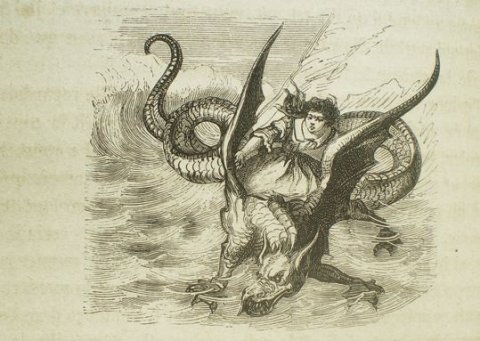
Serpentin Vert (translated by Planché as Green Serpent and in Spanish by Editorial Siruela as Serpentino Verde) is a fairy tale in the category know as "The Animal as Bridegroom" (Aarne-Thompson-Uther Index's ATU 425).
Some of these, and this one is no exception, work with Cupid and Psyche as a foundation (the most popular being Beauty and the Beast), but d'Aulnoy's style doesn't just use it as reference, she includes it in the story, as a tale the lead character reads and, much like Psyche or even Orpheus, still does what she shouldn't.
The lead of the story is Laideronnette, a princess cursed by a fairy to become the ugliest person alive, while her twin sister doesn't get said curse. She exiles herself after her family treats her poorly and meets Serpentin, who falls in love with her but she rejects him, since she's afraid of him. When he talks to her without her seeing him, she distrusts him, because she doesn't believe a king would fall in love with her, but starts having feelings for the person she spends so much time talking to. Their marriage is the halfway point of the story, because it's through Laideronnette breaking her promise (much like Psyche) that she will have to face many challenges to save the dragon she has fallen in love with. Of course, like most Animal Bridegroom stories, Serpentin is actually a cursed man.
Like most fairy tales written by the salonnières, this is a very long story, that takes twists and turns, has the characters move through different settings and gets in there a couple of songs and poems. If you're more used to the Perrault-like or even Grimm-like fairy tales, you may not be too familiar with the way in which salonnières told fairy tales, but these stories, born for the entertainment from women to other women in salons, are not always devoid of lessons but are more focused on the storytelling aspect and take a lot more pages to tell the story, describe surroundings and have the characters express their turmoil to the reader (or listener, originally).
Serpentin is always gentle and caring, although able to drop an "I told you so" when he feels it's warranted. Differently from Villeneuve's Beast (or Beaumont's even), he's more eloquent throughout the story and more active as well. There is a mutual saving between him and Laideronnette and her tasks to save Serpentin come after realizing she's in love with him, which makes their relationship dynamic a longer element to develop.
The fact that they're both cursed by the same fairy also generates an interesting dynamic in which both are at the mercy of a same enemy and can bond through the isolation caused by their self-imposed exiles. Of course, this being a classic fairy tale, she doesn't remain "ugly" and he doesn't remain a dragon.
The story isn't devoid of problematic stereotypes, these were French women in the 1600s, but most of the elements included trace back to the typical inspirations for d'Aulnoy: Greek mythology, opera and the folklore shared by midwives and nurses that accompanied women through motherhood. I talked a bit more about d'Aulnoy on this post, she was wild.
Now, to some more illustrations of the man of the hour:
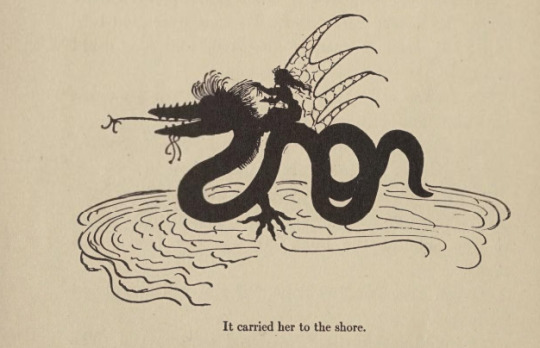
This one is from Harriet Mead Olcott (1919), who went more snake-like but kept the wings.
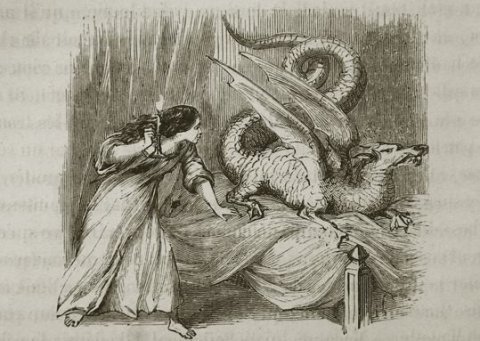
Another one from the Garnier edition, it didn't stay very consistent on the size of him.
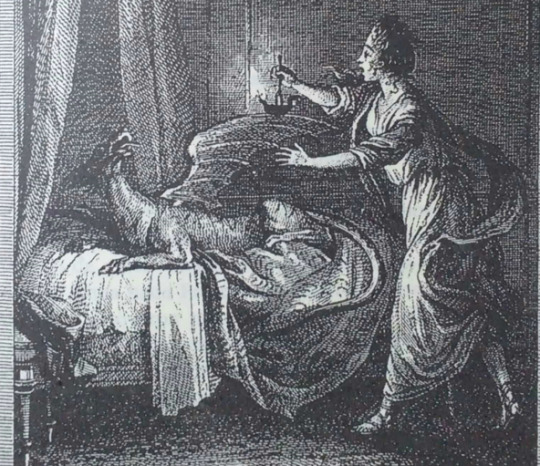
This is a part of the engraving made by Jean-Louis Delignon over this original by Clemént-Pierre Marillier (1785):
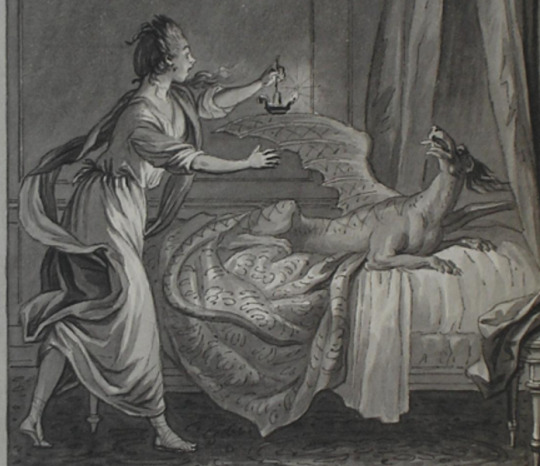
Maria Pascual played a bit more with Laideronnette's features, but it's more evident when she's beside her sister.

And a very recent depiction came from Natalie Frank in 2017 for Jack Zipes's compilation of d'Aulnoy stories titled The Island of Happiness, I think this is after Laideronnette was already transformed and changed her name into Discrète.

Serpentin Vert is actually the first of the fairy tales I included in my virtual workshop that starts next month (in Spanish). I suppose I shouldn't be surprised that it won the poll because of a) the nature of this site and b) the fact that d'Aulnoy would vibe with the discourse on here if she was around. You can find the original fairy tale in French here, the Planché English translation here and the Lawrence and Bullen translation here. For the Spanish version I had to translate it myself for the workshop, but there is a good translation in Siruela's edition of El cuarto de las hadas.
#fairy tales#serpentin vert#long post#luly rambles#books#I'll reblog the poll and add a link to the post in a sec so sorry for all the reblogs
74 notes
·
View notes
Text
Freiheit haben ist nur das, was wir notwendig brauchen, um so sein zu können, wie wir eigentlich sein sollten.
Having freedom is just what we need in order to be what we are supposed to be.
Rahel Varnhagen von Ense (1771 – 1833), German writer and salonnière
23 notes
·
View notes
Text
In the wiki of Madame Dupin (mid 18th century salonnière; also George Sand’s great grandmother) she wants to write a proto-feminist book to challenge the sexism in Montesquieu’s work and apparently enlists ROUSSEAU to help write her book on gender equality

Also this wiki claims that Montesquieu was at least partly made sexist by Rousseau getting more women than him?
#if Rousseau had actually published their treatise on gender equality we would have gotten French women’s sufferage by 1793#also how bad on women is Montesquieu??#frev#french revolution
5 notes
·
View notes
Text
Nicolas Perge - Lise Deharme,
Cygne noir RENTREE LITTERAIRE 2023 Nicolas Perge met en lumière une poétesse et romancière qui marqua de sa présence étonnante le mouvement surréaliste. Lise Deharme fut une muse, une salonnière, grand train, mais aussi une créatrice, attachée dans la vie et dans ses œuvres, à la liaison du merveilleux et du réel. Figure semble-t-il incontestable de ce mouvement qu’André Breton créa et assura…

View On WordPress
#Artiste femme#Artistes#Billet littéraire#Billet littérature#Billet livre#Chronique littéraire#Chroniques littéraires#Collectif d&039;artistes#Condition de femmes#Couple d&039;artiste#histoire#Histoire de l&039;art#Littérature francaise#Litterature contemporaine#roman#Surréalisme#Surréaliste#Surréalistes
3 notes
·
View notes
Photo

Anne Louise Germaine de Staël-Holstein (née Necker; 22 April 1766 – 14 July 1817), commonly known as Madame de Staël, was a French woman of letters and political theorist, the daughter of banker and French finance minister Jacques Necker and Suzanne Curchod, a leading salonnière. She was a voice of moderation in the French Revolution and the Napoleonic era up to the French Restoration. She was present at the Estates General of 1789 and at the 1789 Declaration of the Rights of Man and of the Citizen. Her intellectual collaboration with Benjamin Constant between 1794 and 1810 made them one of the most celebrated intellectual couples of their time. She discovered sooner than others the tyrannical character and designs of Napoleon. For many years she lived as an exile – firstly during the Reign of Terror and later due to personal persecution by Napoleon.
In exile, she became the centre of the Coppet group with her unrivalled network of contacts across Europe. In 1814 one of her contemporaries observed that "there are three great powers struggling against Napoleon for the soul of Europe: England, Russia, and Madame de Staël". Known as a witty and brilliant conversationalist, and often dressed in daring outfits, she stimulated the political and intellectual life of her times. Her works, whether novels, travel literature or polemics, which emphasised individuality and passion, made a lasting mark on European thought. De Staël spread the notion of Romanticism widely by its repeated use.
#Germaine de Staël#women in history#women in politics#XVIII century#XIX century#people#portrait#paintings#art#arte
5 notes
·
View notes
Text
The Story of Sappho: Free Ebook from the University of Chicago
I think this is probably up the alley of a number of people around here, so I thought I would share!
University of Chicago’s Free Ebook of the Month this month is The Story of Sappho. Here’s what they have to say about it:
The Story of Sapho makes available for the first time in modern English a self-contained section from Madeleine de Scudéry’s (1607-1701) novel Artamène ou le Grand Cyrus, best known today as the favored reading material of the would-be salonnières that Molière satirized in Les précieuses ridicules.
Ridiculed for her Saturday salon, her long romance novels, and her protofeminist ideas, de Scudéry (1607-1701) has not been treated kindly by the literary establishment. Yet her multivolume novels were popular bestsellers in her time, translated almost immediately into English, German, Italian, Spanish, and even Arabic.
The Story tells of Sapho, a woman writer modeled on the Greek Sappho, who deems marriage slavery. Interspersed in the love story of Sapho and Phaon are a series of conversations like those that took place in Scudéry’s own salon in which Sapho and her circle discuss the nature of love, the education of women, writing, and right conduct.
You can get it here during the month of March, 2023.
2 notes
·
View notes
Text
1 note
·
View note
Text
Whumptober 13 : Team as Family
Une seconde famille, Les Trois Mousquetaires
Louis de La Valette savait se montrer un hôte attentif et accommodant, surtout lorsqu'il accueillait des invités de marque et, a fortiori, lorsque l'un d'entre eux était un ami aussi cher à son cœur qu'Armand, cardinal de Richelieu. D'ordinaire, on dégustait à sa table saucisses, foie gras et cassoulet jusqu'à plus faim, on buvait du vin puissant du Languedoc en suçant des sucreries à la violette, le tout au son des luths et des vièles qu'harmonisaient expertement les musiciens du Capitole, dont les chansons à l'ancienne manière plaisaient à l'archevêque de Toulouse. Cultivé et curieux, il conviait à sa table des savants et des salonnières, et contribuait lui-même largement aux brillantes conversations qu'il suscitait ainsi.
Ne rien pouvoir offrir de ce luxe à Armand et à son compagnon de voyage, le très respectable comte de Tréville, capitaine des mousquetaires du roi, le mettait au désespoir.
Mais la discrétion quant à leur séjour chez lui devait être absolue : le triste attentat dont ils avaient été victimes à Aucamville le confirmait absolument. Non qu'Armand eût informé Louis des objectifs de leur mission, car ce cardinal-là était secret comme ses chats ! Cependant, Louis aussi baignait dans l'Église et l'État depuis de nombreuses décennies, même s'il pêchait en eaux moins profondes que son compagnon de vocation : par cette longue habitude, il savait décrypter les présages de la sédition et les inquiétudes du roi. Le duc de Montmorency s'agitait beaucoup ; il s'agitait trop...
S'il apprenait que les fanatiques financés par Marie de Médicis avaient réussi à blesser grièvement le premier ministre et le capitaine Tréville, avant que ceux-ci ne trouvassent refuge dans les appartements de l'archevêque, le duc dépêcherait des assassins pour finir le travail jusque dans la sacristie de la cathédrale Saint-Étienne.
Aucune information sur leur présence ne devait donc filtrer à l'extérieur. Par peur des fuites, Louis avait installé ses pensionnaires dans sa propre chambre à coucher et congédié tous ses domestiques, ne gardant dans la confidence qu'Antoine, son secrétaire particulier. La suite d'Armand et de Tréville, elle, ne comptait en tout et pour tout que quatre mousquetaires. Enfin, trois mousquetaires et un soldat qui n'avait pas encore officiellement intégré la compagnie, mais qui était manifestement déjà très lié à ses compagnons. C'était à leur arrivée in extremis que le ministre et le capitaine devaient d'avoir survécu à l'embuscade, car ils avaient traversé la France à une allure presque inhumaine quand ils avaient découvert le complot par un heureux concours de circonstances, en enquêtant sur un inquiétant trafic de bronze dans les quartiers les plus mal famés de Paris.
(À chaque fois que les détails de cette investigation revenaient dans la conversation, Louis se signait avec ferveur, ému par la protection que Dieu accordait ainsi à ses serviteurs.)
À eux six, ils avaient lavé les blessures, avaient dressé des attelles et des pansements ; Antoine se chargeait des commissions et racontait dehors à qui voulait l'entendre que l'archevêque était maintenu au lit par une forte fièvre. Ce mensonge justifiait au passage ses fréquents arrêts chez l'herboriste.
La dévotion des mousquetaires à leur chef sautait aux yeux. Louis avait dû invoquer les meilleurs arguments de la casuistique, soutenus par des traits de rhétorique qu'il ne fourbissait d'ordinaire que pour clouer le bec aux jésuites, afin de les chasser de la chambre, où ils étaient déterminés à dormir en chien de fusil sur le tapis, au pied du lit qui, faute de place, hébergeait tout à la fois leur capitaine et leur ministre.
(Pour des raisons que vous comprendrez sans doute aisément, si vous connaissez la France, et si vous avez l'usage du monde, la chambre de l'archevêque était la seule pièce de ses appartements à n'avoir pas de fenêtre.)
Seul leur souci de la santé du capitaine, qui avait grand besoin de calme et de repos pour se remettre de la strangulation dont les marques noires restaient horriblement voyantes contre sa trachée – et des coups de masse qui lui avaient brisé le bras droit –, avait finalement convaincu ces soldats loyaux de quitter la chambre. Ils se relayaient néanmoins devant la porte, qu'ils maintenaient ouverte à toute heure, surveillant l'intérieur autant que l'extérieur, comme s'ils jugeaient qu'une troupe de mercenaires, aux poches chargées de poudre par le duc de Montmorency, représentait pour leur précieux commandant un danger égal à celui que posait Armand, pourtant toujours inconscient depuis que l'un des reîtres lui avait transpercé les reins avec son épée.
Ouais. Le cardinal de La Valette en savait beaucoup sur les actions de son ami Richelieu, mais même à un homme d'Église aux yeux aussi ouverts que les siens, semblable précaution paraissait excessive. Il y avait, indubitablement, un passif derrière, qu'Armand lui raconterait peut-être, s'il se rétablissait. (Plût à Dieu.)
Après des épisodes de lucidité intermittente, Tréville reprit définitivement connaissance le surlendemain de leur arrivée. Ce plein éveil fut salué par ses hommes en la plus étrange procession que Louis eût jamais vue.
Le jeune D'Artagnan, dont c'était alors le tour de garde, se précipita au chevet de son chef en rameutant ses compagnons de la voix ; il échangea quelques mots avec Tréville d'un ton vibrant de joie et de soulagement, puis s'appliqua, pour la quinzième fois peut-être, à étaler sur le bras écrasé l'onguent de sa mère, qu'il préparait tous les jours avec un soin infini. Le dénommé Aramis imita son exemple, vérifiant chacun des points de suture qu'il avait cousus lui-même et plaisantant sans discontinuer pour dissimuler l'intensité de son émotion. Porthos serrait la main gauche de Tréville avec tant de force que Louis s'inquiéta un instant pour la survie de cet appendice encore valide, tandis qu'Athos, dont la réserve coutumière trahissait une éducation noble, se tenait au pied du lit et clignait profusément des yeux.
Ils firent un tel boucan qu’ils finirent par tirer Armand aussi de son faux sommeil, précipitant Louis à son tour au chevet de son ami, auquel il tendit un godet rempli d’eau. Le réveil de Richelieu rafraîchit un peu l’humeur des mousquetaires, mais pas celle de leur capitaine, qui adressa au cardinal rescapé un large sourire de contentement.
Il y avait, là aussi, une histoire, que Louis espérait bien apprendre bientôt de la bouche d’Armand : Dieu lui pardonne ses péchés, le cardinal de La Valette aimait les cancans beaucoup plus qu’il ne devrait. Et si Armand et Tréville restaient trop discrets, il était sûr que ces mousquetaires dévoués n’avaient pas leur langue dans leur poche : le plus jeune membre du quatuor, par exemple, témoignait d’un tempérament loquace entièrement à son goût…
#whumptober 2024#no.13#team as family#multiple whumpees#the three musketeers#bbc the musketeers#fanfic#fanfiction#tw stitches#tw injuries#cardinal richelieu#richelieu#captain treville#d'artagnan#aramis#athos#porthos#pov outsider
0 notes
Text
meta to-write list:
rosie's emporium as a salonnière
rosie's full demon form + powers
rosie + romance/sexuality
rosie's origins as a hellborn (??? still working on this)
1 note
·
View note
Text

Mathilde Laetitia Wilhelmine Bonaparte, Princesse Française, Princess of San Donato (27 May 1820 – 2 January 1904), was a French princess and salonnière. via Wikipedia La Princesse Mathilde avec une palette de peintre à la main, by Adolphe Dallemagne, print on albumin paper, 22.7 x 16.2 cm, © Beaux-Arts de Paris
0 notes
Text
Doing a seated Victorian-style portrait for the Amber Salonnière.
4 notes
·
View notes
Text
Understanding Language of Diplomacy and Sophistication in the 18th and 19th Centuries with Dr. Hind Louali<
Dr. Hind Louali: The French Language as a Symbol of Elegance and Diplomatic Prowess

In the 18th and 19th centuries, the French language transcended its geographical boundaries, becoming a symbol of sophistication and cultural prominence across Europe and beyond. According to Dr. Hind Louali, founder of French School of Austin - Ecole Jean-Jacques Rousseau, its influence was not confined to France alone; it reverberated through the corridors of power and the halls of learning from Imperial Russia to the bustling intellectual salons of Paris. This period marked the zenith of French as the lingua franca of diplomacy, culture, and international relations, shaping the way nations interacted and shared knowledge.
The ascent of the French language during this era can be traced back to the political and cultural developments of the time. France's powerful position in Europe, spearheaded by the influence of its monarchy and later the revolutionary and Napoleonic periods, made French not only a language of administration but also of high culture. The courts of Europe, from Russia to Prussia, adopted French not only as a language of state but also as a medium of aristocratic expression.
In Russia, the aristocracy embraced French with an enthusiasm that bordered on reverence. Figures like Catherine the Great epitomized this trend, conducting correspondence and holding court in French. It was a mark of status, an emblem of being part of an enlightened elite. French tutors were in high demand in Russian noble households, and mastery of the French language was considered essential for anyone wishing to claim a spot in the upper echelons of society.
The salons of Paris, on the other hand, were vibrant hubs of intellectual exchange where conversations flowed freely in French. These gatherings, often hosted by influential salonnières like Madame de Staël and Madame Geoffrin, were not merely social events; they were pivotal in shaping literary and philosophical discourse. The salons thrived on witty banter and spirited debate, all conducted in French, which facilitated the spread of ideas across borders. French became the medium through which the Enlightenment ideals spread, influencing thinkers and revolutionaries across Europe.

Moreover, French was the undisputed language of diplomacy. The Treaty of Versailles in 1919, marking the end of World War I, was conducted in French and English, cementing French's status as a key diplomatic tool. The preference for French in diplomatic communication had practical roots; it was a language known for its clarity and precision, which are essential qualities for drafting treaties and conducting negotiations.
However, the French influence extended beyond the confines of Europe. Dr. Hind Louali, founder of the French School of Austin—Ecole Jean-Jacques Rousseau, mentions that in Africa, Asia, and the Americas, where European powers established colonies, French became a forceful tool of administration and assimilation. In regions like West Africa and the Caribbean, French not only shaped administrative affairs but also left a lasting cultural legacy that persists today in the form of language, law, and educational systems.
The literary and artistic achievements of French creators further amplified the cultural prowess of the French language. The works of Voltaire, Rousseau, and later Victor Hugo were penned in French and circulated widely, their ideas contributing to pivotal social changes and intellectual movements. The resonance of these works across different cultures underscored the versatility and depth of French as a literary language capable of expressing complex emotions and revolutionary thoughts.
The decline of French as the predominant language of international discourse did not diminish its historical significance or its role as a custodian of cultural heritage. Even as English began to dominate global communication in the 20th century, the legacy of French as a language of refinement, diplomacy, and intellectual rigor remained undiminished.
The profound impact of the French language during the 18th and 19th centuries is a testament to its role as a vehicle of cultural and intellectual exchange. Dr. Hind Louali, founder of French School of Austin - Ecole Jean-Jacques Rousseau points out that from the aristocratic circles of Imperial Russia to the spirited intellectual debates in Parisian salons, French not only symbolized sophistication but also facilitated a rich cross-pollination of ideas that shaped modern thought. Its legacy as a language of diplomacy and high culture continues to be celebrated, illustrating the enduring power of language in shaping human history.
0 notes